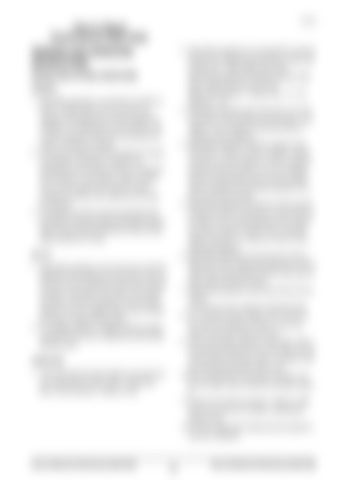T012133E
How to Read Performance Data Plate 2. Rated lifting capacities do not exceed 85 % of the tipping load on outriggers fully extended as determined by SAE J765 - Crane Stability Test Code. Rated lifting capacities for partially extended outriggers are determined from the formula. Rated Lifting Capacity = (Tipping Load - 0.1 x Tip Reaction) / 1.25. 3. Rated lifting capacities above blue lines in the chart are based on crane strength and those below, on its stability. They are based on actual load radius increased by boom deflection. 4. Rated lifting capacities include the weight of main hook block (1,100 lbs. for 50 ton capacity), optional secondary hook block (580 lbs. for 22 ton capacity), auxiliary hook block (330 lbs. for 6.2 ton capacity), sling and auxiliary lifting devices and their weights shall be subtracted from the listed capacities to obtain the net load to be lifted. 5. Rated lifting capacities are based on freely suspended loads and make no allowance for such factors as the effect of wind, sudden stopping of lads, supporting surface conditions, inflation of tires, operating speeds, side loads, etc. Side pull on boom or jib is extremely dangerous. 6. Rated lifting capacities do not account for wind on lifted load or boom. Rated lifting capacities and boom length shall be appropriately reduced, when wind velocity is above 20 mph (9 m/sec). 7. Rated lifting capacities at load radius shall not be exceeded. Do not tip the crane to determine allowable loads. 8. Do not operate at boom lengths, radii, or boom angle, where no capacities are shown. Crane may overturn without any load on the hook. 9. When boom length is between values listed, refer to the rated lifting capacities of the next longer and next shorter booms for the same radius. The lesser of the two rated lifting capacities shall be used. 10.When making lifts at a load radius not shown, use the next longer radius to determine allowable capacity. 11.Load per line should not exceed 11,400 lbs. (5,200 kg) for main winch and 12,300 lbs. (5,600 kg) for auxiliary winch. 12.The boom angle before loading should be greater to account for deflection.
WARNING AND OPERATING INSTRUCTIONS NOTES FOR LIFTING CAPACITIES GENERAL 1. Rated lifting capacities on the RATED LIFTING CAPACITY CHART apply only to the machine as originally manufactured and normally equipped by TADANO LTD. Modifications to the machine or use of optional equipment other than that specified can result in a reduction of capacity. 2. Construction equipment can be hazardous if improperly operated or maintained. Operation and maintenance of this machine must be in compliance with information in the operation, safety & maintenance manual supplied with machine. If these manuals are missing, order replacements through the distributor. 3. The operator and other personnel associated with this Machine shall fully acquaint themselves with the latest American National Standards Institute (ANSI) safety standards for cranes. SET UP 1. Rated lifting capacities on the chart are the maximum allowable crane capacities and are based on the machine level on firm supporting surface under ideal job conditions. Depending on the nature of the supporting surface, it may be necessary to have structural supports under the outrigger floats or tires to spread the loads to a larger bearing surface. 2. For outrigger operation, outriggers shall be properly extended with tires free of supporting surface before operating crane. OPERATION 1. Total rated loads have been tested to and meet minimum requirements of SAE J1063 - Cantilevered Boom Crane Structures - Method of Test.
How to Read the Performance Data Plate
51
How to Read the Performance Data Plate





